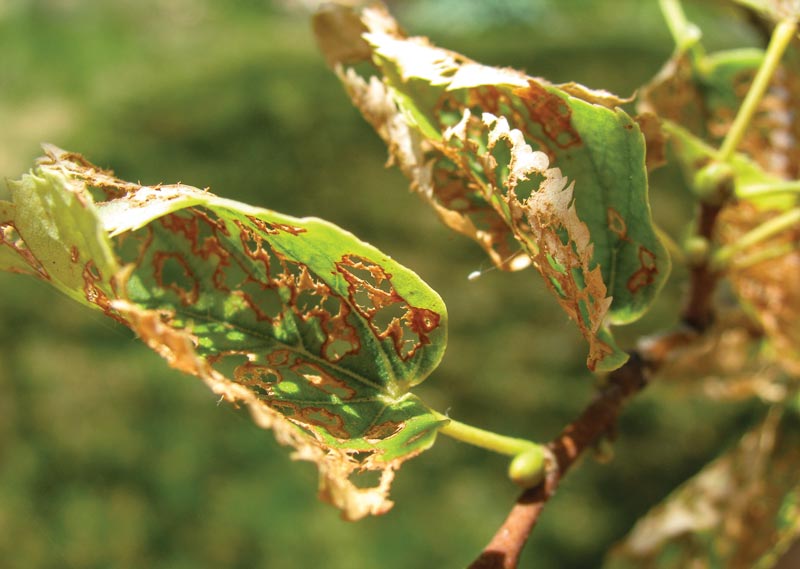
Damage to a linden tree caused by Japanese beetles. This is a classic pest pair, and roses are a favorite plant of Japanese beetles as well. Photos by John C. Fech
There are average, run-of-the-mill pests that target the trees and shrubs on your golf course, and then there are Super Pests — the ones that really threaten the thriftiness and longevity of those same features. Super Pests cause a golf course superintendent to reconsider whether a plant is worth the expense and effort of treating year in and year out, or whether removal is the better option. Some of the worst Super Pests are Japanese beetles, emerald ash borers, euonymus scale and bagworms.
To further help characterize the myriad pests that loom on the golf course, superintendents should ask themselves whether a pest is really a threat to the tree. The answer to that question can really shed light on the situation and help with the categorization of relatively minor vs. heavy-duty pests.
For example, an infestation of fall webworms looks really bad. After all, they’re typified by a gregarious mass of webbing that engulfs entire branches of many shade tree species. On the whole, though, they really don’t cause long-lasting damage. Some species, such as lilac/ash borers, tend to be invaders of trees under stress from other factors, such as compacted soils, drought or storm damage. Other pests often attack seemingly healthy trees on their own and have the capacity to cause the tree to go into a tailspin that it probably won’t recover from. It’s the latter that we call Super Pests.
Borers, piercers and defoliators: A trio of tree terrors
Though there are certainly exceptions, three general groups of insects threaten trees to some degree.
Borers are internal feeders that attack woody plants, destroying the conductive vessels that are essential to long-term survival. These tend to be the most damaging.
Piercers/suckers are external feeders that suck sap and other plant juices. They can be serious, especially if combined with the influence of abiotic stressors.
Defoliators are external feeders that damage leaves by skeletonizing, chewing holes in or consuming entire leaves. Normally, these are the least damaging, especially with deciduous trees, as the leaves will be replaced later in the season or the following season if the tree is in otherwise good health.
Considering their importance, how do you know whether you have Super Pests? The best way is to engage in a thorough, regular scouting and monitoring program. Why is this so important? Super Pests, by nature, are tough to control and usually require early intervention, as opposed to run-of-the-mill pests, which can be controlled more easily. Scouting is also a critical technique in targeting insecticide applications to the most vulnerable life stage, such as the crawler stage for armored scales.
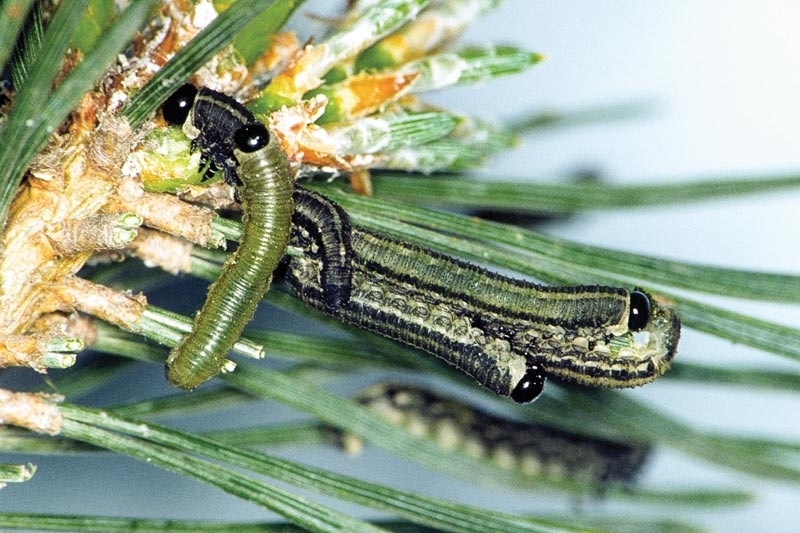
Larvae of pine sawfly — a defoliator — can devour lots of needles in a short period of time.
An effective Super Pest monitoring program can be implemented in at least two formats. The first is to empower every maintenance crew worker to inspect plantings as they go about their work every day, making notes about symptoms and signs of infestation. The other is to train a select few dedicated scouts who regularly visit high-value trees and shrubs to document abnormal appearances and insect presence. Regardless of which approach you choose, just like looking closely at turf roots and crowns, it’s important to look at all sides of the plant surfaces — that is, the undersides of the tree leaves, the bark fissures, terminal buds, etc.
Simply listening to golfers when they mention seeing oddities can be helpful as well. When Fred and Bob make a comment about “that linden in the rough on No. 12,” they could be alerting you to a potentially serious problem that needs attention.
Mapping tree pests
As Super Pests tend to be ones that are long-lived in the golfscape, pest mapping is also a high-return-on-investment control technique. Sure, drawing out areas of infestation, identifying individual tree species that are affected and highlighting specific insect pests of concern takes time and costs money for materials and labor, but it provides a much more specific set of parameters than relying on memory alone for pest control decisions. Mapping can be sophisticated, with the use of various software packages, or it can be as simple as using a pen and flip chart. The important thing is that you do it.

Fall webworms may appear to be a Super Pest of trees, but their impact is relatively insignificant.
You can get a head start on some of the mapping work if you know which woody plants have a history or association with certain pests — for example, American linden and Japanese beetles; Colorado spruce and bagworms; eucalyptus and lerp psyllids; crape myrtle and aphids; ficus and whiteflies.
These “pest pairs” should not automatically exclude certain tree species from the golf course, but their presence does call for judicious attention to the possibility that problems are more likely to occur in some trees and shrubs versus others. Knowing these historical occurrences can assist greatly with pest mapping by helping steer scouts to trees and shrubs with a reputation for injury and guiding them on what to look for. In many cases, linden, spruce, eucalyptus, crape myrtle and ficus are well adapted, but this acknowledgment simply brings more information and perhaps a caveat about various woody plant species.
The value of golf course tree diversity
Tree diversity helps suppress the success of Super Pests. It’s all too common for many species to be underutilized in the golfscape — in other words, for too many of too few species to predominate. Instead of this routine, the 10% rule should be used as a guide.
The 10% rule? Like the one-third rule for mowing — where no more than a third of the leaf tissue should be removed with any one mowing operation — the 10% rule restricts tree plantings to no more than a tenth of a given genus (oak, ash, maple, spruce, fir, fig, etc.). Ideally, several of the genera planted on a golf course would be composed of various genus and species, such as chinkapin oak, red oak, swamp white oak, sawtooth oak, bur oak, etc.
When a pest species invades, a diverse golfscape will be affected to a much lesser degree than one that is reliant on just a few specific plants. Fortunately, there are many good tree-species sources for reference. The best approach is to visit with the local Extension horticulturists, entomologists and arborists at the land-grant university in your state. Local arboretums offer similar information about well-adapted, underutilized species, both online and at their locations.
The Super Pest lineup
If your scouting efforts reveal the presence of the following Super Pests, it’s prudent to consider whether their host tree should remain in the golfscape in light of the pest management that will be required.
Borers
Emerald ash borer. Emerald ash borers (EAB) do not follow the typical pattern of targeting weak specimens. They attack all species of ash, in all stages of development, and do not distinguish between healthy and stressed trees. They’re especially injurious because they feed in the xylem and phloem. After just a few years of infestation, they can greatly diminish the capacity to move water and nutrients throughout the tree, and the tree will die. Infested trees will have dieback starting in the upper third of the canopy and might see an increase in woodpecker feeding as well. Valuable specimens should be treated preventively once EAB has been established within 15 miles of the golf course.
Editor’s note: For more on emerald ash borer, including life cycle information and a decision-making guide to help you address damage, see A tree owner’s guide to emerald ash borer by Jonathan L. Larson.

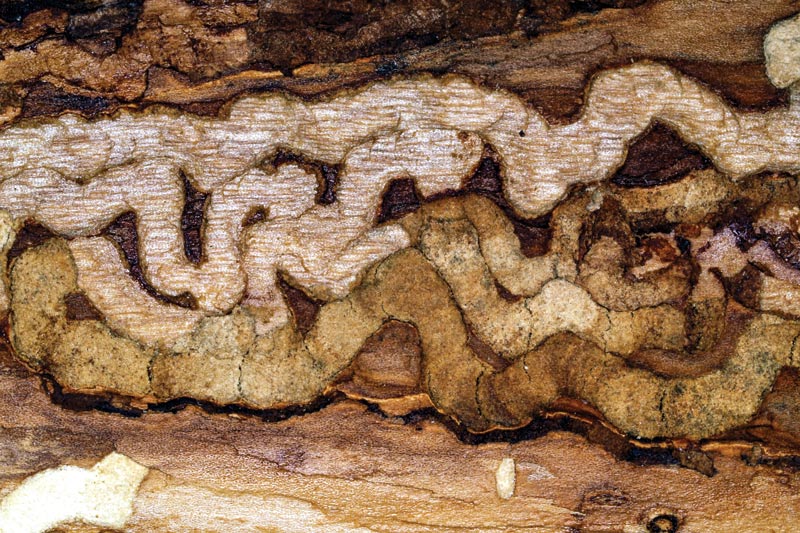
Emerald ash borers attack all species of ash in all stages of development and do not distinguish between healthy and stressed trees. The second photo shows emerald ash borer damage.
Bronze birch borer. A major threat to white-barked birch. When a tree initially becomes infested, the foliage on some branches in the upper crown begins to yellow in midsummer, progressing to browned or dead leaves as the season progresses. This results in the death of smaller branches in the upper crown. Over time, large branches begin to die back, and eventually the entire tree may die. After repeated feeding activity, ridges begin to appear on the bark of the trunk and larger branches as the cambium tissue is damaged. A good indicator of bronze birch borer activity is the appearance of D-shaped exit holes on the trunk and on larger branches as adult borers begin to emerge from the tree.
Zimmerman pine moth. Pine moth caterpillars cause significant damage to scotch, Austrian and red pines. The first obvious symptoms are the presence of large resin or pitch masses on the tree trunks where the larvae are feeding beneath the bark. Pitch masses are usually golf ball-sized and are located at branch whorls where the branches join the main trunk. Fresh pitch masses where the larvae are active will be white, soft and shiny. The larvae hatch from the eggs and crawl under loose bark scales or into wounds to spend the winter. In spring, the larvae enter the bark and feed for the next few months. In late summer, the larvae pupate at the end of the larval tunnel, and two weeks later emerge as moths to start the cycle over. These caterpillars can cause extensive damage via branch loss from broken/cracked branches that break off at the sites of infestation. Early detection is the key to control.
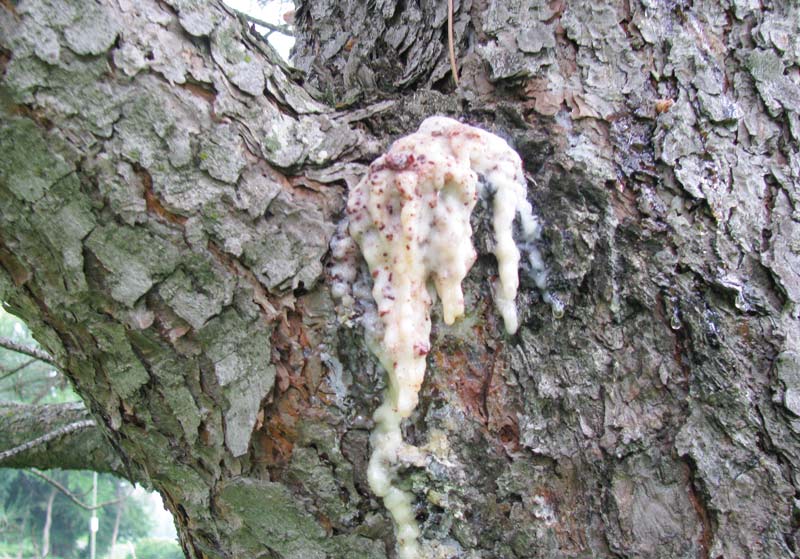
A symptom of Zimmerman pine moth.
Pine wilt nematode. Carried by the pine sawyer beetle, pine wilt nematodes are not true borers, but in borer-esque fashion, they are pests of the resin canals in a tree’s vascular system. Adult beetles are attracted to recently dead or dying trees. Egg laying takes place in crevices in the bark after feeding. After eggs hatch, the larvae feed for several weeks in the cambium layer before boring into the sapwood of the tree branches and trunk. While larval feeding is certainly damaging to pine trees, it’s not nearly as disruptive of the nutrient and water flow as the damage caused by the presence of the transferred nematodes.
Piercers/suckers
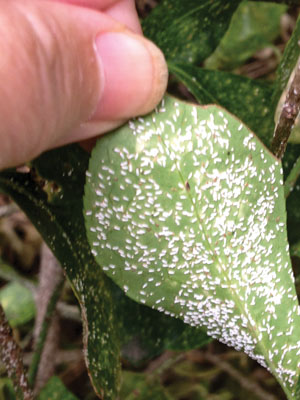
Armored scale insects. Oystershell, euonymus (right), magnolia, golden oak scale, pine needle scale, etc., are easy to overlook because they’re small and immobile most of their lives and do not resemble a typical insect. They attach themselves to twigs, then grow a protective, waxy covering that can appear to be part of a branch to the untrained eye. Scale insects can build up to large infestations, with branches dying before they are noticed. Some types have one generation per year, and others have two generations. For effective control, applications must be made in the mobile crawler stage.
Whiteflies. The ultimate piercing/sucking insect. A big pest of ficus trees in California and Florida, whiteflies have multiple generations each year. One of the biggest hurdles to controlling them is their feeding location on the undersides of leaves, where it’s hard to direct an insecticidal application.
Spruce spider mites (cool season) and two-spotted spider mites (warm season). Though not actually insects, mites feed similarly by extracting plant juices. In just two to three weeks after feeding, the tree takes on a dull appearance. After three to four weeks, the dull turns to bronze, and the tree is well on its way to severe injury. Early detection is a must. Spruce spider mites can have two population peaks in a season and thrive in temperatures below 85 F. Two-spotted spider mites peak in the heat of the summer, on days with highs of 95 F and lows of 75 F. Control by switching active ingredients and using specific miticides, not general insecticides.
Defoliators
Japanese beetles. Extensive defoliators, Japanese beetles feed on over 300 species of trees and shrubs. The larvae are some of our worst white grubs that consume the roots of turf. In spring, after pupation, adults emerge, ready to feed again. The sheer number of adults feeding and their above-average ability to fly enhance their potential for damage. Care must be taken to avoid insecticidal treatments for trees in flower, as those are prohibited by federal pesticide laws.
Bagworms. Despite their appearance, spruce and other trees have not been decorated with ornaments for Christmas — what you’re seeing is damage from bagworms. Bagworms feed on dozens of tree and shrub species, but luckily, we go through booms and busts with them. Constant inspection is paramount. Bags have a classic conical shape, made from tree/shrub parts. The bag color is generally brown, as leaves/needles become dehydrated. Bags start small and enlarge but retain the same shape. Bagworms eat fast — entire branches can be defoliated in a week — and work their way down from the top, a helpful infestation symptom to watch for. Early detection and intervention are critical in bagworm control.
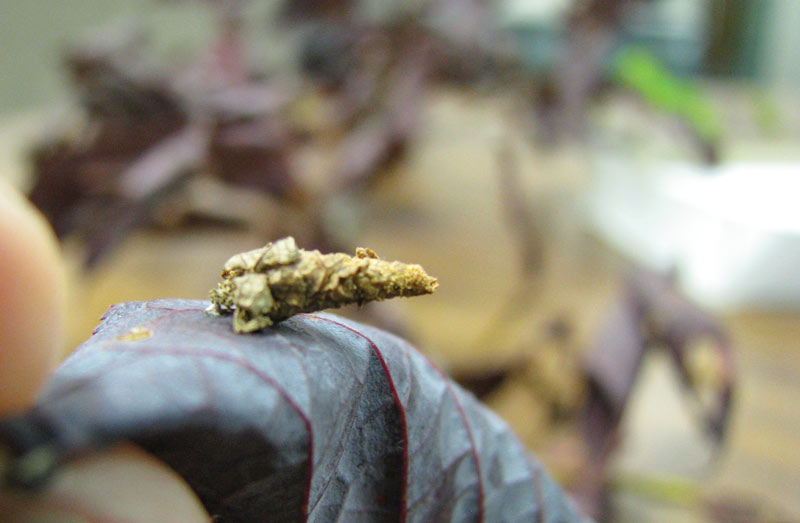
Bagworms can be difficult to detect if you don’t have a regular inspection program established.
Pine sawflies. Sawfly larvae resemble caterpillars but are actually the larvae of primitive wasps. Sawflies take on the green to bluish-green color of the needles they consume, making them harder to detect. Sawflies have a herd-like behavior, feeding gregariously in numbers ranging from 20 to 50 or more. Most species feed almost exclusively on 1- or 2-year-old needles. Pine sawflies are generally early-season pests, so insecticide applications are best timed to control young larvae as they appear in early to midspring.
John C. Fech is a horticulturist and Extension educator with the University of Nebraska-Lincoln. He is a frequent and award-winning contributor to GCM. Jonathan L. Larson is an assistant professor and Extension educator at the University of Kentucky in Lexington.